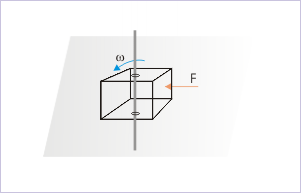| << Chapter < Page | Chapter >> Page > |
The study of rotational motion is an important step towards the study of real time motion. Rotational motion is essentially a circular motion about a point or an axis (for three dimensional bodies). The rotation of a rigid body about an axis passing through the body itself is termed "spin motion" or simply "spin". On the other hand, rotation about an external axis is termed "orbital motion". We shall treat both these types of rotation in the same manner as treatment of either rotation types is same from the point of view of governing laws of motion.
Rotation is one of two basic components of general motion of rigid body. The motion of a rigid body is either translation or rotation or combination of two. In translation, each of the particles constituting the rigid body has same linear velocity and acceleration. On the same footing, we say that each of the particles constituting the rigid body has same angular velocity and acceleration in rotation. A consequence of this analogy is that each particle constituting the rigid body moves in a circular motion such that their centers lie on a straight line called axis of rotation.
Pure translation refers to a straight line motion. Similarly, pure rotation refers to rotation about a fixed axis. Importantly, pure translation excludes rotation whereas pure rotation excludes translation.
A rigid body in rotation about a fixed axis should continue to rotate with the given angular velocity indefinitely unless obstructed externally. The angular velocity of rotation is changed by external cause in the same manner as in translational motion. In the case of translation motion, the external cause is "force". We have to investigate what is the equivalent "cause" in the case of rotational motion?
Let us consider a rigid block placed over a smooth horizontal surface as shown in the figure, which is subjected to a force across one of its face. What is expected? The center of mass will move with linear acceleration following Newton's second law. However, the force is not passing through the center of mass. As such, the face of the block will also have turning tendency in the direction shown.
The motion of block

Let us now imagine if the body is pierced through in the middle by a vertical bar with some clearance. The vertical bar will inhibit translation and the block will only rotate about the vertical bar. The question is what caused the block to turn around? Indeed it is the force that caused the angular motion. However, it is not only the force that determined the outcome (magnitude and direction of angular velocity and acceleration). There are other considerations as well.
Rotational motion

We all have the experience of opening and closing a hinged door in our house. It takes lesser effort (force) to open the door, when force is applied farther from the hinge. We can further reduce the effort by applying force normal to the plane of the door. On the other hand, we would require greater effort (force), if we push or pull the door from a point closer to the hinge. If we apply force in the radial direction (in the plane of door) towards the hinge, then the door does not rotate a bit - whatever be the magnitude of force. In the nutshell, rotation of the door depends on :

Notification Switch
Would you like to follow the 'Physics for k-12' conversation and receive update notifications?